Best Cities to Live in Italy for a Fresh Start

Get a Free Moving Quote Now!
Start Your International Moving Journey





Looking for a new pace of life without losing access to great food, strong community, and practical comforts? Italy has plenty of cities where daily life feels easier, calmer, and more affordable than what you might be used to. If you’re one of the many people making the leap with help from international movers, this post covers what really matters—costs, stats, and livability. The best cities to live in Italy aren’t always the most famous ones, but they offer stability, charm, and quality of life you can feel right away.
What Makes Bologna a Good Fit for Remote Workers?
Bologna blends student energy, work opportunities, and well-connected infrastructure. Moving to Italy often means choosing between big cities and quiet towns—Bologna gives you both in one place. Average rent sits around €850 for a one-bedroom in the center, or €650 just outside. Daily living costs average €800 per person without rent. Unemployment hovers around 4.5%, which is low for Italy. Public transit is reliable, with a monthly pass costing €36.
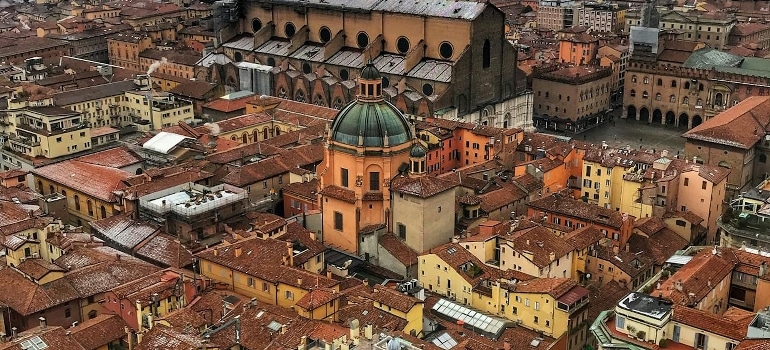
You’ll find some of the best healthcare in Emilia-Romagna. Internet speeds average over 100 Mbps, which supports remote workers and creatives. Bologna’s compact layout makes walking or biking easy. You’re also within an hour of Florence and Milan by train, which adds flexibility for travel or work. The city doesn’t feel overwhelming, but it’s far from sleepy.
Bologna: High-Speed Living in a Mid-Sized City
Bologna offers a balanced mix of strong infrastructure, low unemployment, and reliable digital connectivity.
- Population: ~390,000
- Rent (1BR city/outside): €850 / €650
- Living cost (excl. rent): €800/month
- Unemployment: 4.5%
- Transit pass: €36
- Internet: 100+ Mbps
Why Is Lecce Gaining Popularity with Budget-Conscious Expats?
If you’re aiming for peace and affordability, Lecce delivers. Moving to Europe from USA can be financially tough, but Lecce cuts your overhead fast. One-bedroom apartments go for around €500 in the center or €400 further out. You’ll need about €650 monthly for living expenses beyond rent. Southern Italy’s slower pace is real here. Unemployment in Puglia is higher—about 11%—so Lecce isn’t ideal for job-seekers. But it’s great for freelancers, remote workers, or retirees.
You’ll find sunshine most of the year, clean air, and low pollution levels. Monthly transit passes cost €25, and healthcare access is solid. While internet speeds are lower than the north (around 40–60 Mbps), they’re reliable. The city’s compact size means everything’s within walking range, and the historic center stays lively without being overrun by tourists.
Lecce: Low Costs in the Sunny South
Lecce stands out for affordable rent, low daily expenses, and a warm climate nearly all year.
- Population: ~95,000
- Rent (1BR city/outside): €500 / €400
- Living cost (excluding rent): €650/month
- Unemployment rate: 11%
- Transit pass: €25/month
- Internet speed: 40–60 Mbps
Is Turin Still Italy’s Most Underrated City?
Turin isn’t on every expat’s radar, but it should be. The city offers elegance without high prices. International household goods movers report more families and remote workers heading here lately. Rent averages €700 for a one-bedroom in the city or €500 outside it. Living costs come in around €750 per person, excluding rent. The regional unemployment rate is about 6%, and average net salary is roughly €1,550/month. A monthly transit pass is €38.
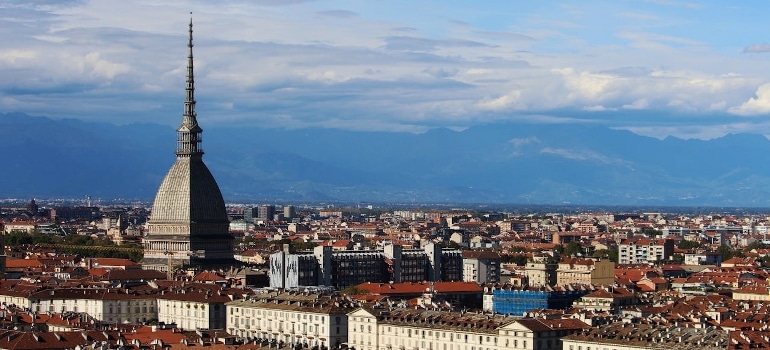
You’re one hour from Milan by train, which opens up work and travel options. Turin has a strong industrial and tech sector, plus a growing startup scene. Internet coverage is excellent, and fiber is common in city neighborhoods. Healthcare is reliable and well-rated, and the cost of groceries and services remains moderate. If you want stability, culture, and daily comfort, this is a smart pick.
Turin: Affordable Urban Life Near Milan
Turin delivers big-city amenities, lower rent than Milan, and strong internet for remote work.
- Population: ~850,000
- Rent (1BR city/outside): €700 / €500
- Living cost (excluding rent): €750/month
- Unemployment rate: 6%
- Transit pass: €38/month
- Internet speed: 100+ Mbps
How Does Trento Keep Topping Quality-of-Life Rankings?
Trento often ranks #1 in national livability reports, and for good reason. International movers in NYC see a steady rise in clients relocating to northern Italy, and Trento checks most boxes. Rent is about €750 in the city center and €600 outside it. Daily costs hover around €750 per person, not including rent. Public transit passes cost €47 monthly. Unemployment in Trentino-Alto Adige is around 3.3%—the lowest in Italy. Air quality is high, streets are clean, and green space is everywhere.
Healthcare is consistently ranked among the best in the country. With the Alps surrounding the city, access to hiking, skiing, and nature is unbeatable. Internet speeds are high, averaging over 90 Mbps. If safety, nature, and order matter to you, Trento is one of the best cities to live in Italy.
Trento: Top Ranked for Quality of Life
Trento leads Italy in livability rankings with low unemployment, clean air, and access to nature.
- Population: ~118,000
- Rent (1BR city/outside): €750 / €600
- Living cost (excluding rent): €750/month
- Unemployment rate: 3.3%
- Transit pass: €47/month
- Internet speed: 90+ Mbps
Is Lucca a Practical Choice for Long-Term Living?
Lucca keeps a low profile but delivers real value. International moving cost can stretch budgets, but Lucca offers balance once you’re settled. Rent in the historic center averages €700, or €500 just outside. Monthly living expenses hover around €700 per person beyond rent. Unemployment is relatively low in Tuscany, and Lucca’s pace supports freelance and remote work well. A public transit pass costs about €35, but the city is walkable and bike-friendly.
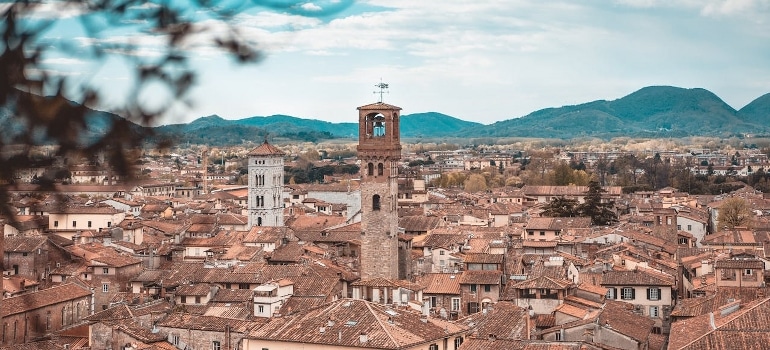
Healthcare access is strong, and local clinics are easy to reach. Fiber internet is available in most areas. Lucca’s size keeps everything manageable. It avoids the crowds of Florence while offering similar architecture and charm. You’ll find farmers markets, quiet piazzas, and consistent municipal services that make day-to-day life easier.
Lucca: Historic Charm with Practical Perks
Lucca keeps costs moderate while offering fiber internet, solid healthcare, and a walkable city center.
- Population: ~89,000
- Rent (1BR city/outside): €700 / €500
- Living cost (excluding rent): €700/month
- Unemployment rate: ~6.5%
- Transit pass: €35/month
- Internet speed: 80–90 Mbps
What Makes Trieste a Smart Pick for Retirees?
Trieste stands out for affordability and healthcare. Container shipping companies say clients targeting northern Italy often choose this border city. One-bedroom rents average €600 in the center and €450 outside. Cost of living beyond rent is about €700/month per person. Transit passes cost €37. Healthcare facilities are strong, and the city hosts one of Italy’s best oncology centers. The sea is right there, and Slovenia’s border is just 20 minutes away.
Crime rates are low, and public services are consistent. Trieste has fewer tourists than Venice but offers the same kind of views. You’ll find a unique mix of Italian, Slavic, and Austrian influences. The food is different. The rhythm is slower. Many older expats appreciate that. Internet infrastructure is good, with average speeds around 85 Mbps. Overall, it’s a strong fit if you want a livable coastal city without chaos.
Trieste: Coastal Calm with Cross-Border Access
Trieste blends Adriatic views, border proximity, and lower rent than nearby cities.
- Population: ~200,000
- Rent (1BR city/outside): €600 / €450
- Living cost (excluding rent): €700/month
- Unemployment rate: ~5%
- Transit pass: €37/month
- Internet speed: 85 Mbps
Why Do More Expats Choose Perugia Over Rome?
Perugia offers real value, especially for those on tighter budgets. International movers in NJ note a steady flow of students and young families choosing it over Rome. Rent runs about €500 in the center and €400 in suburban zones. Monthly living costs excluding rent sit at €650 per person. Transit passes cost €30. You’ll find public services, cultural events, and university amenities all packed into a small area.
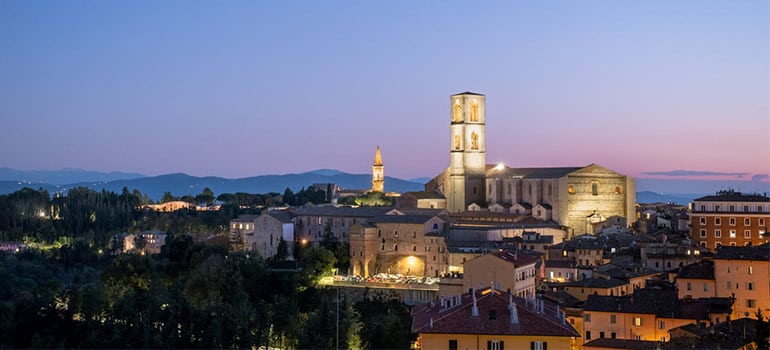
Unemployment in Umbria is around 8%, but remote work is viable with average internet speeds of 70–80 Mbps. The hilltop layout may require more walking, but the city is compact and safe. Perugia is quieter than Florence or Rome but offers strong educational infrastructure and good medical facilities. It also connects well to Florence, Rome, and Assisi via regional trains.
Perugia: Budget Living in a Student Hub
Perugia supports students and families with low rent, steady services, and reliable local transit.
- Population: ~165,000
- Rent (1BR city/outside): €500 / €400
- Living cost (excluding rent): €650/month
- Unemployment rate: 8%
- Transit pass: €30/month
- Internet speed: 70–80 Mbps
Is Bari Italy’s Next Big Coastal City?
Bari is attracting attention thanks to affordability and infrastructure upgrades. Moving to Italy on a budget gets easier when housing and transport stay within reach. Rent costs around €550 for a city-center one-bedroom, €420 outside. Living costs excluding rent are roughly €650 monthly. A public transit pass runs about €35. Bari’s train station is a hub for southern Italy, and the airport has strong European connections. Beaches are close, and the city center is undergoing an upgrade.
Crime is moderate, and the police presence has grown. Internet access is widely available, though speeds may be slower in older buildings (around 50–60 Mbps). Bari’s economy is mixed, with growth in logistics and tech. It’s not flooded with tourists, so it still feels local. For those craving an urban vibe with access to the sea, it’s one of the best cities to live in Italy.
Bari: Southern Growth with Coastal Benefits
Bari combines improving infrastructure, seaside living, and competitive housing costs.
- Population: ~315,000
- Rent (1BR city/outside): €550 / €420
- Living cost (excluding rent): €650/month
- Unemployment rate: ~11%
- Transit pass: €35/month
- Internet speed: 50–60 Mbps
How Does Verona Balance Beauty With Practicality?
Verona manages to stay livable without sacrificing charm. International movers often recommend it for those who want northern quality at a slightly lower cost than Milan or Venice. Rent prices are around €700 for a city-center apartment and €500 outside the main area. Cost of living averages €750/month per person beyond rent. Unemployment in Veneto is about 4.8%. Internet access is solid, with speeds averaging 90 Mbps. A transit pass runs €38/month.
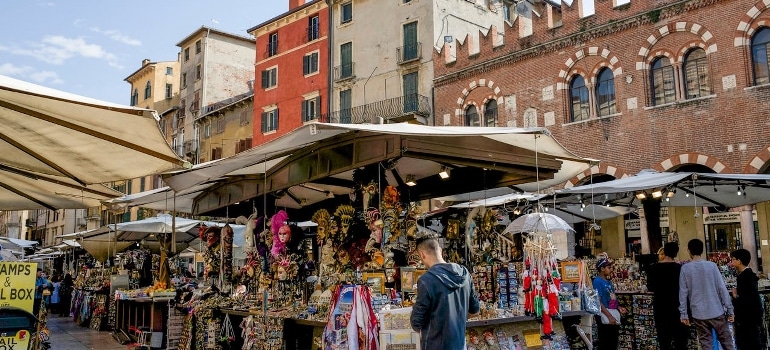
Healthcare services are reliable, and regional hospitals rank well. Verona’s appeal comes from its size: it’s small enough to navigate but big enough to offer work and culture. You’re within easy reach of Milan and Venice by train. The city supports both traditional and modern lifestyles—small businesses thrive, and digital nomads have started taking notice.
Verona: Northern Italy Without Milan Prices
Verona gives you northern stability, fast train access, and manageable rent in a scenic setting.
- Population: ~260,000
- Rent (1BR city/outside): €700 / €500
- Living cost (excluding rent): €750/month
- Unemployment rate: 4.8%
- Transit pass: €38/month
- Internet speed: 90 Mbps
Can Cagliari Really Work for Digital Nomads?
Cagliari is making waves with expats looking for island life with modern perks. Moving to Europe with remote work in mind? This could be your spot. Rent in Cagliari averages €600 in the center and €450 on the outskirts. Living costs excluding rent are about €700/month. Transit passes cost €30, and the city is walkable. Internet infrastructure has improved, with many buildings offering speeds of 80–100 Mbps. Sardinia’s healthcare ranks well, and Cagliari’s main hospital is modern and accessible.
The climate is sunny and dry most of the year. Flights to mainland Italy are frequent and cheap. The pace is slower, but services are reliable. Local government has also introduced coworking programs and incentives for digital workers. If you want real change without sacrificing internet or healthcare, this island capital is a solid bet.
Cagliari: Island Life with Digital Nomad Appeal
Cagliari delivers decent internet, low transit costs, and a slow-paced environment ideal for remote work.
- Population: ~150,000
- Rent (1BR city/outside): €600 / €450
- Living cost (excluding rent): €700/month
- Unemployment rate: ~12%
- Transit pass: €30/month
- Internet speed: 80–100 Mbps
Best Cities to Live in Italy: What You Should Really Keep in Mind
First, focus on the numbers. Southern cities usually cost less, but job options are limited. On the other hand, northern cities cost more but offer better healthcare, transit, and internet. Next, check real rental listings—not averages—and confirm what you’ll actually pay each month. Also, look into local unemployment rates and neighborhood internet speeds, especially if you work remotely. If you’re coming from abroad, make sure your visa lets you live and work in the region you choose. Don’t assume every city has the same services or pace. Some trade charm for convenience, others offer peace but less opportunity. Before making the move, line up your priorities—climate, cost, services, or connection. Then choose based on what fits your daily life, not just the scenery. In the end, picking the best cities to live in Italy comes down to clear priorities and honest research. Everything else follows.
